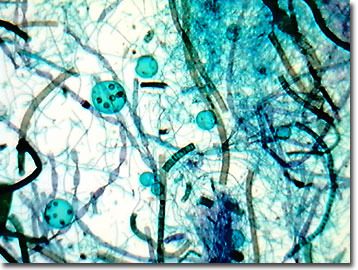Brightfield Digital Image Gallery
Mixed Green Algae
Prominent members of the kingdom Protista, algae are most common in aquatic habitats, but occur in nearly every environment. They range in size from unicellular microscopic pond inhabitants to giant kelp that reaches 200 feet (60 meters) in length. Algae produce a significant percentage of the Earth's oxygen, are the base of the food chain for nearly all aquatic life, and provide food and industrial products for humans.

Of the algal species, green algae, members of the division Chlorophyta, are identified by their perceived green color that results from light selectively reflecting from the chlorophyll photopigments in their characteristic chloroplasts. With more than 8,000 species, the diverse group occurs in a wide variety of habitats worldwide. Both unicellular and multicellular green algal fossils date back to the Cambrian Period (540 to 500 million years ago), but probably evolved nearly a billion years ago.
In common with higher plants, green algae feature both chlorophylls a and b, an alternation of generations, and cellulose cell walls. Another plant trait shared by this polyphyletic group is the storage of photosynthetic products as starch inside the double-membrane bounded chloroplasts. Whether microscopic freshwater forms such as the colonial Volvox or Spirogyra, or the larger seaweeds such as sea lettuce (Ulva taeniata), which stretch beyond 14 feet in length on the American Pacific Coast, chlorophytes are amazingly productive in the generation of carbohydrates and oxygen. Some species of green algae live on the surface of snow, on tree trunks, in soils, or symbiotically with protozoans, hydras, or lichen-forming fungi. One explanation for the excruciatingly slow movements of the Amazonian three-toed sloth might be the symbiotic green algae that occur in the microscopic groove of each body hair. No other wild animal is a host to plants living on its body. The commensal relationship is thought to provide shelter for the algae and a degree of camouflage for the host sloth from predators such as the harpy eagle. Sun-bleached and eroded remains of calcium carbonate, deposited by species in the genus Halimeda, are largely responsible for the sparking white sand beaches of the Caribbean Islands. The deepest-occurring green alga known at this time, Johnson-sea-linkia profunda, is found attached to bedrock at a depth of 157 meters off the Bahamas coastline.
Contributing Authors
Cynthia D. Kelly, Thomas J. Fellers and Michael W. Davidson - National High Magnetic Field Laboratory, 1800 East Paul Dirac Dr., The Florida State University, Tallahassee, Florida, 32310.
BACK TO THE BRIGHTFIELD IMAGE GALLERY
BACK TO THE DIGITAL IMAGE GALLERIES
Questions or comments? Send us an email.
© 1995-2022 by Michael W. Davidson and The Florida State University. All Rights Reserved. No images, graphics, software, scripts, or applets may be reproduced or used in any manner without permission from the copyright holders. Use of this website means you agree to all of the Legal Terms and Conditions set forth by the owners.
This website is maintained by our
Graphics & Web Programming Team
in collaboration with Optical Microscopy at the
National High Magnetic Field Laboratory.
Last Modification Friday, Nov 13, 2015 at 02:19 PM
Access Count Since September 17, 2002: 21094
Visit the website of our partner in introductory microscopy education:
|
|
